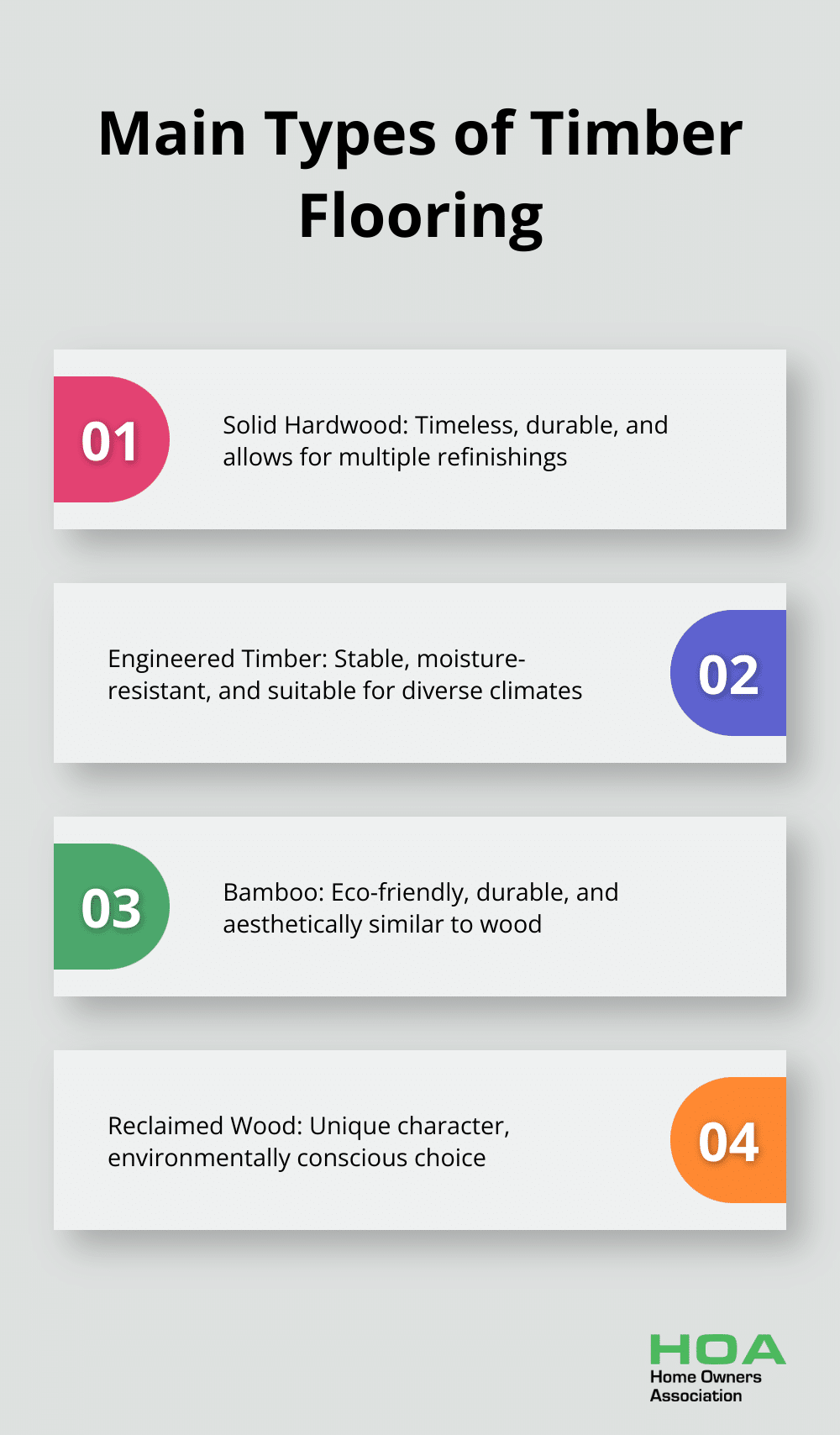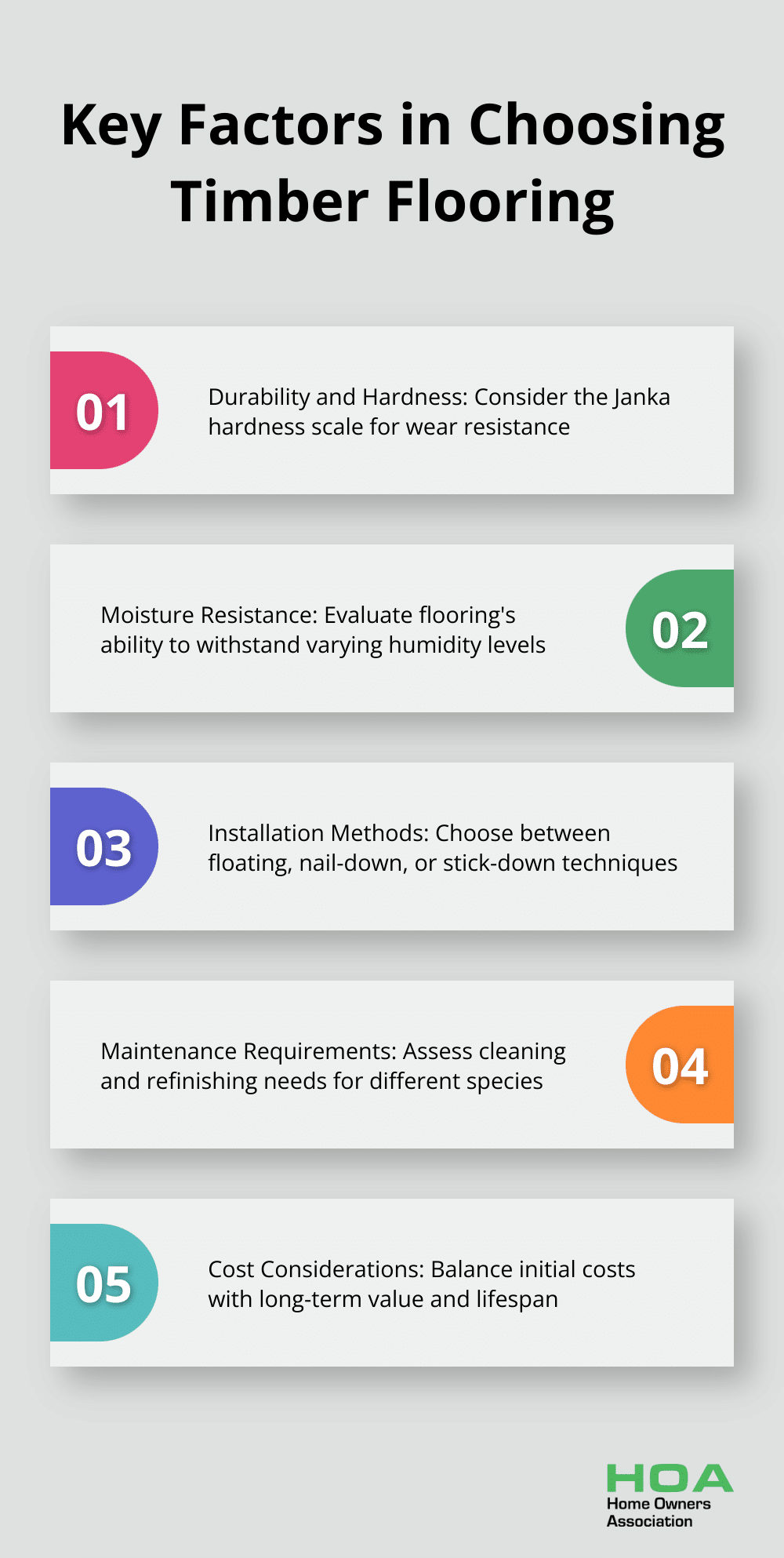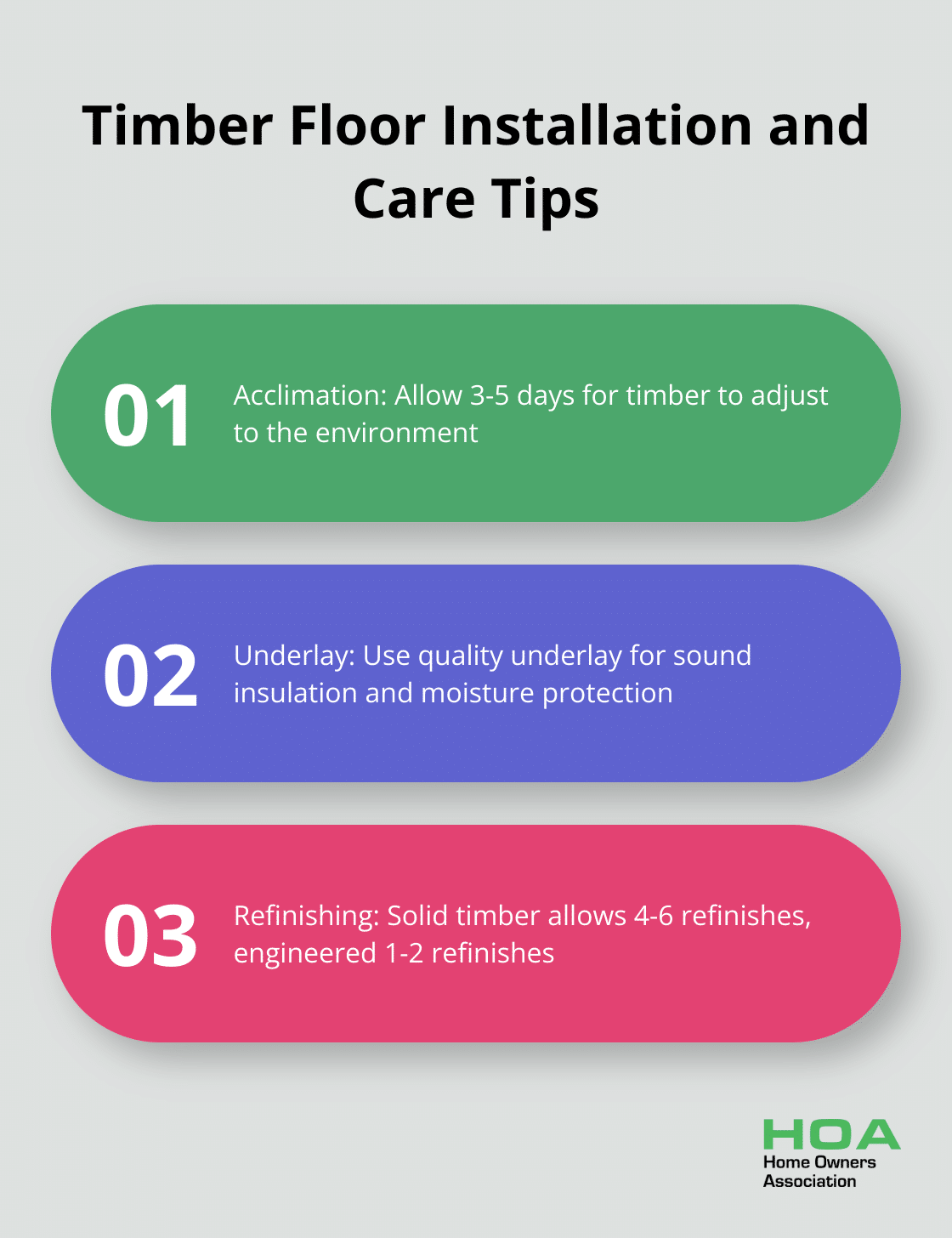
At Home Owners Association, we understand the importance of choosing the right flooring for your home. Timber floors are a popular choice, offering warmth, beauty, and durability.
In this post, we’ll explore various timber floor options to help you make an informed decision. From classic hardwood to innovative engineered solutions, we’ll cover the pros and cons of each type, along with essential factors to consider during selection and installation.
Types of Timber Flooring
At Home Owners Association, we’ve observed various timber flooring options gain popularity among Australian homeowners. Let’s explore the main types you’ll encounter in the market today.

Solid Hardwood Flooring
Solid hardwood flooring is a timeless choice that maintains its appeal. Crafted from a single piece of timber, it offers unmatched durability and longevity. Popular Australian hardwoods like Spotted Gum and Blackbutt make excellent choices. Blackbutt is a strong, durable hardwood that can be used for a range of exterior and interior applications including framework, decking and flooring. Solid hardwood allows for multiple sandings and refinishings, which significantly extends its lifespan. However, this type of flooring is sensitive to moisture and temperature changes, making it less suitable for high-humidity areas or below-ground installations.
Engineered Timber Flooring
Engineered timber flooring has surged in popularity, especially in Australia’s diverse climate zones. This flooring type consists of a real wood veneer atop multiple layers of plywood or high-density fiberboard. Its layered construction provides superior stability and moisture resistance compared to solid hardwood. Engineered timber is less prone to warping, cupping, or gapping compared to solid hardwood, especially in wider planks. It works well in areas where solid hardwood might struggle (such as basements or regions with high humidity). It’s also typically more affordable than solid hardwood, offering a cost-effective option for many homeowners.
Bamboo Flooring
Bamboo flooring has attracted attention due to its eco-friendly nature and durability. Although technically a grass, bamboo offers aesthetics similar to wood and often surpasses traditional hardwoods in hardness. This sustainable alternative appeals to environmentally conscious homeowners who don’t want to compromise on style or durability.
Reclaimed Wood Flooring
Reclaimed wood flooring presents a unique, environmentally conscious choice. This option gives new life to old timber, often sourced from demolished buildings or old barns. Each piece of reclaimed wood tells a story, adding character and history to your home. It’s crucial to ensure that reclaimed wood undergoes proper treatment and certification for use as flooring to avoid potential issues with pests or structural integrity.
When selecting your timber flooring, consider factors such as your local climate, the specific room’s usage, and your budget. Home Owners Association recommends consulting with flooring professionals to ensure you choose the best option for your unique needs. The right timber flooring can significantly enhance your home’s value and aesthetic appeal for years to come.
Now that we’ve covered the main types of timber flooring, let’s examine the key factors you should consider when making your selection.
Factors to Consider When Choosing Timber Flooring
Selecting the right timber flooring for your home requires careful evaluation of several key factors. This chapter explores the essential aspects you should consider to make an informed decision.

Durability and Hardness
The Janka hardness scale serves as a valuable tool to assess timber durability. Hardness is measured based on the wood’s resistance to denting and wear, and is carried out by embedding a small steel ball into the wood. Australian hardwoods like Spotted Gum and Ironbark rank high on this scale. These woods excel in high-traffic areas. Softer woods such as Pine suit low-traffic zones or bedrooms better.
Moisture Resistance and Climate Adaptability
Australia’s diverse climate demands flooring that withstands varying humidity levels. Engineered timber flooring often outperforms solid hardwood in this aspect. In coastal areas with higher humidity, engineered options can reduce the risk of warping compared to solid timber.
Installation Methods
The installation method affects both cost and performance. Floating floors (popular with engineered timber) can be installed faster than traditional nail-down methods. Direct stick-down methods, while more time-consuming, often provide superior stability and sound insulation.
Maintenance Requirements
Different timber species and finishes require varying levels of maintenance. Oak flooring with a UV-cured oil finish might need re-oiling periodically. Between the two types of floor finish, urethane is the most durable. There’s an actual protective layer, so the hardwood is extra protected.
Cost Considerations
While initial costs matter, it’s important to consider long-term value. Solid hardwood flooring might cost more upfront than engineered options. However, its ability to be refinished multiple times can extend its lifespan (potentially offering better value over time).
When weighing these factors, align your choice with your specific needs and local conditions. The next chapter will provide valuable insights into the installation and maintenance of your chosen timber flooring, ensuring you get the most out of your investment.
Mastering Timber Floor Installation and Care
Acclimation: The Foundation of Stability
Proper acclimation of timber flooring to its new environment is essential. This process usually takes 3-5 days (depending on timber type and local climate). Store the flooring in the installation room, maintaining consistent temperature and humidity levels. This step prevents future warping or gaps.
Underlay: The Unsung Hero
The right underlay impacts your floor’s performance significantly. A quality underlay provides sound insulation, moisture protection, and helps level minor subfloor imperfections. One of the biggest benefits of hard floor underlay is that impact sounds are significantly reduced. The loudness and sharpness of footstep sounds are deadened. For concrete subfloors, use a vapor barrier with a minimum thickness of 0.2mm. Cork underlay (an eco-friendly option) offers natural sound insulation and thermal properties.
Cleaning: The Daily Ritual
Regular cleaning forms the basis of timber floor maintenance. Use a microfiber mop or soft-bristled broom daily to remove dust and debris. For deeper cleaning, use a damp (not wet) mop with a pH-neutral cleaner designed for timber floors. Avoid steam mops and excessive water, as these can damage the wood.
Refinishing: The Art of Renewal
Even well-maintained timber floors may need refinishing over time. The frequency depends on foot traffic and timber hardness. Solid timber floors can typically be refinished 4-6 times throughout their lifespan. Engineered timber usually allows for 1-2 refinishes, depending on the top layer thickness.
When it’s time to refinish, consider updating the stain color to refresh your home’s look. Always hire a professional for this task to ensure the best results and avoid damaging your valuable flooring.

Final Thoughts
Timber floor options offer homeowners a blend of natural beauty, durability, and versatility. Each type brings unique characteristics, allowing you to find the perfect match for your home’s style and functional requirements. Factors such as durability, moisture resistance, installation methods, and cost all influence an informed choice.
Professional installation and maintenance maximize the lifespan and performance of timber floors. Proper acclimation, appropriate underlay selection, and regular care contribute to the longevity and appearance of your flooring investment. The expertise of professionals prevents costly mistakes and ensures optimal results.
Home Owners Association provides Melbourne homeowners with expert advice, resources, and access to trade pricing for flooring needs. Our team helps you navigate timber flooring options with confidence (ensuring a successful home improvement project). The right timber flooring enhances the beauty of your home and adds value and comfort to your living space for years to come.





